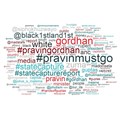Marketing & Media trends
Industry trends
BizTrends Sponsors
Trending
Jobs
- Marketing Manager Johannesburg
#BizTrends2018: Is the 280-character count the end of brands on Twitter?

In September, the microblogging platform announced that it will double the limit to a long-winded 280-characters. And the collective eye-roll from Twitter users was felt around the world.
Deep down inside, I hoped it would never really happen. That maybe a Twitter engineer had confused a ‘limit’ button for an ‘edit’ button. That fake news had infiltrated the social network’s headquarters.
But no. My timeline was soon clogged up with bad poetry, listicles and emoji porn.
So what is it about this change that has Twitter purists up in arms?
To me, it feels like the ultimate sell out. A cheap ploy to entice more users to join the troubled platform that hasn’t yet found a model that brings in the big bucks. My tolerance for bulls#it is low.
I fear this increased character count will open the flood gates, allowing meaningless ranting and raving, bumbling and wafting to flow through my Twitter stream. We all know that’s what Facebook is for.More importantly, I worry that brands will snap up this opportunity to force as many product features as they can into a single tweet.
Fake users will have more space to brainwash us with their lies.
I’m concerned that agencies will lazily duplicate their Facebook content on Twitter because the character limit allows them to.
And I know that hashtag stuffing will become a full-blown epidemic.
Nothing will cause a user to unfollow a brand as quickly as any of the above. And this may very well be the death of many brands on Twitter – unless they evolve.
I’m not one to make predictions but instead, I will share my hope for social in the year to come…
True Twitter engagement
Brands need to stop using Twitter to push product. Very few people go on Twitter to follow brands unless they want to complain or win something. Rather use the platform to truly help your followers.
280 characters allows a bank or network provider to actually assist customers instead of giving them a number to call. It will allow community managers to inject more personality into their responses instead of replying with functional words only.
Personalised content is now a realistic option for us. In fact, there is no excuse not to tailor our responses to our audiences.
The way for brands to win on Twitter will be with solid influencer strategies built on long-term and authentic relationships. The real trick is finding the sweet spot where your influencers and product intrinsic meet.
Social commerce
Facebook is not going anywhere. While the urge to dismiss it as a cat-video, family-rant-fest platform is strong; so is its value in driving social commerce. Brands and agencies must focus on using the platform to not just create brand love but also turn those warm, fuzzy feelings into leads and sales.According to Sprinkler, 26% of Facebook users who click on ads make purchases.
Similarly, Instagram will continue to grow its social commerce prowess. The highly immersive, visual platform continues to be brand-friendly, with at least 80% of users following businesses on it, reveals Instagram’s COO, Marne Levine.
Always-on content reimagined
As social media marketers, we have been grappling with the value of always-on content for the last few years. Without it, we have to work harder to reach and engage with our target audiences when campaign time rolls around.
But in its current form, it feels pointless to create content for the sake of it, desperately trying to tap into obscure ‘tactical’ opportunities like ‘Clean your Refrigerator Day’ in a bid for empty engagement.
In the world of WACKY holidays, it’s #CleanYourRefrigeratorDay. Take a look at what’s inside the idNerd refrigerator. Better yet, come into the office and see for yourself! #JoinTheNerds. Follow our Linkedin network for idNerd creative opportunities: https://t.co/8CsT7gkV9T pic.twitter.com/Y3pEluCcox
— idNerd (@idNerdHK) November 15, 2017
- Either always-on content should be generic, brand-awareness content paired with a reach and frequency paid-media strategy, as per Facebook best practice, which could change at any given point, or
- Always-on content should evolve into teaser and wrap-up content that hugs campaign content and continues a long-term and powerful brand narrative. Of course, this is dependent on strong strategic planning and a robust marketing calendar upfront.
These are just some of the social trends I will be focusing on in 2018. Of course there are others, like AI, chatbots, micro-moments, influencers, dark social and live streaming, that just about every other trends article has covered in depth.















